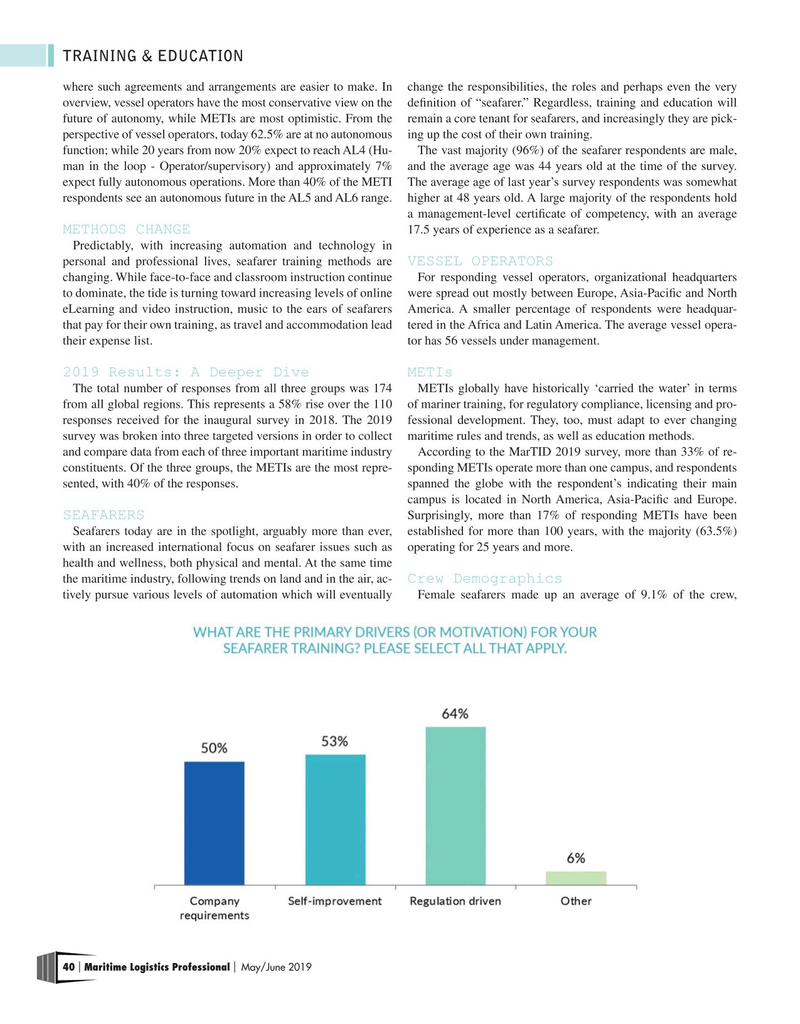
Page 40: of Maritime Logistics Professional Magazine (May/Jun 2019)
US and International Navy Ports
Read this page in Pdf, Flash or Html5 edition of May/Jun 2019 Maritime Logistics Professional Magazine
TRAINING & EDUCATION where such agreements and arrangements are easier to make. In change the responsibilities, the roles and perhaps even the very overview, vessel operators have the most conservative view on the de?nition of “seafarer.” Regardless, training and education will future of autonomy, while METIs are most optimistic. From the remain a core tenant for seafarers, and increasingly they are pick- perspective of vessel operators, today 62.5% are at no autonomous ing up the cost of their own training. function; while 20 years from now 20% expect to reach AL4 (Hu- The vast majority (96%) of the seafarer respondents are male, man in the loop - Operator/supervisory) and approximately 7% and the average age was 44 years old at the time of the survey. expect fully autonomous operations. More than 40% of the METI The average age of last year’s survey respondents was somewhat respondents see an autonomous future in the AL5 and AL6 range. higher at 48 years old. A large majority of the respondents hold a management-level certi?cate of competency, with an average 17.5 years of experience as a seafarer.
METHODS CHANGE
Predictably, with increasing automation and technology in personal and professional lives, seafarer training methods are
VESSEL OPERATORS changing. While face-to-face and classroom instruction continue For responding vessel operators, organizational headquarters to dominate, the tide is turning toward increasing levels of online were spread out mostly between Europe, Asia-Paci?c and North eLearning and video instruction, music to the ears of seafarers America. A smaller percentage of respondents were headquar- that pay for their own training, as travel and accommodation lead tered in the Africa and Latin America. The average vessel opera- their expense list. tor has 56 vessels under management. 2019 Results: A Deeper Dive METIs
The total number of responses from all three groups was 174 METIs globally have historically ‘carried the water’ in terms from all global regions. This represents a 58% rise over the 110 of mariner training, for regulatory compliance, licensing and pro- responses received for the inaugural survey in 2018. The 2019 fessional development. They, too, must adapt to ever changing survey was broken into three targeted versions in order to collect maritime rules and trends, as well as education methods. and compare data from each of three important maritime industry According to the MarTID 2019 survey, more than 33% of re- constituents. Of the three groups, the METIs are the most repre- sponding METIs operate more than one campus, and respondents sented, with 40% of the responses. spanned the globe with the respondent’s indicating their main campus is located in North America, Asia-Paci?c and Europe.
Surprisingly, more than 17% of responding METIs have been
SEAFARERS
Seafarers today are in the spotlight, arguably more than ever, established for more than 100 years, with the majority (63.5%) with an increased international focus on seafarer issues such as operating for 25 years and more.
health and wellness, both physical and mental. At the same time
Crew Demographics the maritime industry, following trends on land and in the air, ac- tively pursue various levels of automation which will eventually Female seafarers made up an average of 9.1% of the crew, 40 Maritime Logistics Professional May/June 2019 | |

 39
39

 41
41
